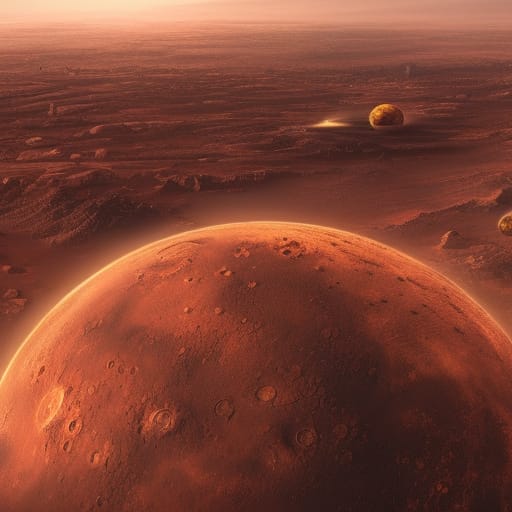Space: Mars

Mars is the fourth planet from the Sun and has long captivated the human imagination due to its reddish appearance and potential for future exploration and colonization. Here are the important aspects of Mars:
Distance and size: Mars is located about 227.9 million kilometers (141.6 million miles) from the Sun. It has a diameter of approximately 6,779 kilometers (4,212 miles), making it about half the size of Earth.
Composition: Mars is a terrestrial planet with a rocky surface composed mainly of basalt and iron oxide, which gives it its characteristic red color. Its thin atmosphere consists of roughly 95% carbon dioxide, 2.7% nitrogen, 1.6% argon, and trace amounts of other gases, including oxygen and water vapor.
Orbital and rotation period: Mars takes 687 Earth days to complete one orbit around the Sun. Its rotation period is approximately 24.6 hours, making its day-night cycle very similar to Earth's.
Temperature: Mars has a thin atmosphere, which results in a much colder climate than Earth's. The average surface temperature on Mars is about -63°C (-81°F), with variations ranging from -133°C (-207°F) at the poles to 27°C (80°F) near the equator.
Surface features: Mars has diverse landscapes, including the largest volcano in the solar system, Olympus Mons, and the longest canyon, Valles Marineris. Its surface also shows evidence of ancient riverbeds and polar ice caps, indicating that water once flowed on the planet.
Atmospheric pressure: Mars has a surface pressure of around 6.1 millibars, which is less than 1% of Earth's atmospheric pressure. This low pressure makes it impossible for liquid water to exist on the planet's surface for extended periods.
Magnetic field: Mars does not have a global magnetic field like Earth's, although it does have localized magnetic fields in some regions. The lack of a strong magnetic field is believed to have contributed to the loss of Mars' atmosphere over time.
Moons: Mars has two small, irregularly shaped moons, Phobos and Deimos. They are believed to be captured asteroids and are significantly smaller than Earth's Moon.
Exploration: Mars has been extensively studied by numerous spacecraft, including orbiters, landers, and rovers. Notable missions include NASA's Viking, Mars Global Surveyor, Mars Odyssey, Mars Reconnaissance Orbiter, Mars Science Laboratory (Curiosity rover), and Mars 2020 (Perseverance rover). The European Space Agency's Mars Express and ExoMars missions have also provided valuable data on the planet.
Potential for life: Mars is considered one of the most likely places in our solar system to find evidence of past or present microbial life due to its similarity to Earth and the presence of water ice. Recent discoveries, such as the detection of seasonal methane emissions and the presence of organic molecules, have fueled interest in the search for life on Mars.
Observing Mars: Mars is visible from Earth with the naked eye and appears as a reddish, star-like object. Its brightness and apparent size vary depending on its position in the sky and its distance from Earth.
Mythology: Mars is named after the Roman god of war due to its reddish appearance, which was associated with blood and battle. In Greek mythology, the planet was known as Ares, the god of war.